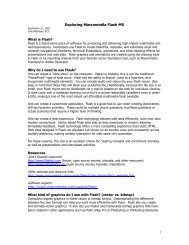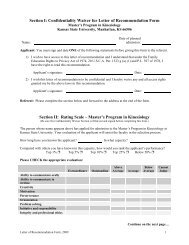The Impact of Body Emphasizing Video Games on Body Image ...
The Impact of Body Emphasizing Video Games on Body Image ...
The Impact of Body Emphasizing Video Games on Body Image ...
- No tags were found...
Create successful ePaper yourself
Turn your PDF publications into a flip-book with our unique Google optimized e-Paper software.
594 Sex Roles (2008) 59:586–601not moderate the overall relati<strong>on</strong>ship between video gameplay and negative body images, the raw BMI scores wereused as the independent variable in a regressi<strong>on</strong> analysis inorder to determine if the BMI would account for asignificant porti<strong>on</strong> <str<strong>on</strong>g>of</str<strong>on</strong>g> the variance in the dependentvariables at time 2. <str<strong>on</strong>g>The</str<strong>on</strong>g> results showed that the BMI didnot account for a significant porti<strong>on</strong> <str<strong>on</strong>g>of</str<strong>on</strong>g> the variance in any<str<strong>on</strong>g>of</str<strong>on</strong>g> the dependent variables (all Fs.05). Thissuggests that the results from the main analyses are robustand independent <str<strong>on</strong>g>of</str<strong>on</strong>g> the BMI and that the bodies <str<strong>on</strong>g>of</str<strong>on</strong>g> thecharacters in the video games are very powerful, whichsupports the third hypothesis.Further regressi<strong>on</strong> analyses were c<strong>on</strong>ducted with theaverage video game play time per week as the independentvariable and the scores <strong>on</strong> the scales and subscales as thedependent variables in order to see if the amount <str<strong>on</strong>g>of</str<strong>on</strong>g> timespent playing video games accounted for a significantporti<strong>on</strong> <str<strong>on</strong>g>of</str<strong>on</strong>g> the variance in these dependent variables. <str<strong>on</strong>g>The</str<strong>on</strong>g>results showed that the average video game play time perweek did not significantly account for significant porti<strong>on</strong>s<str<strong>on</strong>g>of</str<strong>on</strong>g> the variance in any <str<strong>on</strong>g>of</str<strong>on</strong>g> the dependent variables (all Fs.05). This suggests that the results from themain analyses are robust and independent <str<strong>on</strong>g>of</str<strong>on</strong>g> the videogame play habits <str<strong>on</strong>g>of</str<strong>on</strong>g> the participants, which supports thethird hypothesis.Discussi<strong>on</strong>Overall, the results from this study suggest that when maleparticipants played a video game that emphasized muscularmale bodies, they had an increase in their negative bodyimage.Specifically, these results showed that those whoplayed the video game, independent <str<strong>on</strong>g>of</str<strong>on</strong>g> c<strong>on</strong>diti<strong>on</strong>, had adecrease in positive feelings toward their body, had a decreasein their general body esteem, had a decrease in their positiveattitudes toward muscularity, and had a decrease in the drivefor muscularity. This suggests that the participant’s affectiveand cognitive comp<strong>on</strong>ent <str<strong>on</strong>g>of</str<strong>on</strong>g> a negative body-image weresignificantly impacted by video game play. <str<strong>on</strong>g>The</str<strong>on</strong>g>se findingssupport our hypotheses as well as the theorizing.One finding that was interesting was that there was asignificant decrease in the drive for muscularity afterplaying the video game for those in the n<strong>on</strong>-muscularc<strong>on</strong>diti<strong>on</strong>. Thus, after playing a video game that did not putas heavy an emphasis <strong>on</strong> muscles, males had a decrease inthe drive for muscularity. This suggests that not primingparticipants with all muscular images decreased theprobability <str<strong>on</strong>g>of</str<strong>on</strong>g> intending to engage in negative health relatedbehaviors. This is c<strong>on</strong>sistent with our theorizing about howmass media images impact the pursuit <str<strong>on</strong>g>of</str<strong>on</strong>g> muscularity(Ricciardelli and McCabe 2004) because less muscularexposure is related to fewer intenti<strong>on</strong>s to obtain thosemuscles.Also, those in the n<strong>on</strong>-muscular c<strong>on</strong>diti<strong>on</strong> had a decreasein positive attitudes toward muscularity. This finding is notc<strong>on</strong>sistent with our hypotheses because it was predicted thatplaying a video game that c<strong>on</strong>tained all muscular characterswould be related to an increase in the positive attitudestoward muscularity. Thus, exposure to an obese wrestlerlowered body satisfacti<strong>on</strong> compared to those who wereexposured to the muscular c<strong>on</strong>diti<strong>on</strong>. <str<strong>on</strong>g>The</str<strong>on</strong>g> exact reas<strong>on</strong> whythis effect was found is unknown; however several possibleexplanati<strong>on</strong>s exist. One possible reas<strong>on</strong> is that <strong>on</strong>e may notnecessarily expect an obese pers<strong>on</strong> to be as str<strong>on</strong>g as thevideo game portrayed these characters to be. Thus, theparticipants may be thinking that the obese wrestler is n<strong>on</strong>muscular,but can do complex wrestling moves that requiremuscles. Further, the participants may be thinking that theyare in better shape than the obese wrestler, but still cannotlift a pers<strong>on</strong> <str<strong>on</strong>g>of</str<strong>on</strong>g>f the floor, for example.. Another possibleexplanati<strong>on</strong> is that the player’s character may have beenmuscular. It was rare that both characters were obese.<str<strong>on</strong>g>The</str<strong>on</strong>g>refore, all participants got exposed to some muscularcues in the video game, regardless <str<strong>on</strong>g>of</str<strong>on</strong>g> the body shape <str<strong>on</strong>g>of</str<strong>on</strong>g>their randomly assigned computer c<strong>on</strong>trolled opp<strong>on</strong>ent.Although these are plausible explanati<strong>on</strong>s, more work isneeded to specifically examine this effect.Study 2Overview <str<strong>on</strong>g>of</str<strong>on</strong>g> the Current Study<str<strong>on</strong>g>The</str<strong>on</strong>g> results from study 1 suggest that, after male participantsplayed a video game that emphasized the muscularmale body, they had a decrease in their body esteem andattitudes toward muscularity. <str<strong>on</strong>g>The</str<strong>on</strong>g> purpose <str<strong>on</strong>g>of</str<strong>on</strong>g> study 2 was todetermine if playing a video game that emphasized the thinfemale body would increase negative body-images infemale participants.Based <strong>on</strong> the past literature, the Tripartite InfluenceModel, and the results from Study 1, the followinghypotheses were derived:H1: <str<strong>on</strong>g>The</str<strong>on</strong>g>re will be a decrease in body esteem and bodysatisfacti<strong>on</strong> after body emphasizing video game playfor females.H2: <str<strong>on</strong>g>Body</str<strong>on</strong>g> mass index and the number <str<strong>on</strong>g>of</str<strong>on</strong>g> hours spent playingvideo games will not moderate the overall relati<strong>on</strong>shipbetween video game play and negative body- image.If c<strong>on</strong>firmed, both hypotheses would replicate the resultsfrom study 1 by showing that both men and women will havemore <str<strong>on</strong>g>of</str<strong>on</strong>g> an increase in negative body-images after playing avideo game that emphasizes the body. Also, like study 1body mass index and the number <str<strong>on</strong>g>of</str<strong>on</strong>g> hours spent playingvideo games would not moderate the overall relati<strong>on</strong>ship.
















